|
|||||
FlyingRC.net is a
Veteran-Owned site.

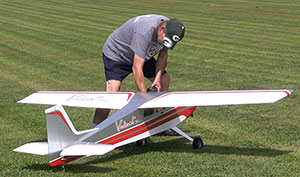 |
| When my first Valiant was destroyed by a receiver failure I thought I would move on to another plane but I just could not get myself to believe that. A friend in Texas had the same thoughts and a new Valiant appeared on my doorstep. Click image to enlarge |
Hangar 9 Valiant – Part Deux
I couldn’t stand to be without this super-fun airframe
Text, photos and video by Tom Hintz
Flight video by – Clark Ponthier
Posted - 8-30-2017
When my Hangar 9 Valiant met its untimely end due to an apparent receiver failure I considered moving on to a newer, more exciting plane. Of course, I also thought joining the Army to go to Vietnam was a bright idea in the mid 60’s. Once again, I was wrong but this time with far less dire potentialities. The Hangar 9 Valiant was one of the most enjoyable planes I have ever flown and I was not ready to give that up. The generosity of a good friend re filled the Hangar 9 Valiant spot in my lineup and I sincerely appreciate his help.
This “re-review” also gives me the chance to revisit the Hangar 9 Valiant kit to see if I could improve the build process or perhaps make it lighter than its already impressive 17lb flying weight that makes performance with my DLE40 Twin almost stunning to folks who find out how small the engine really is. As always, I must balance my desire to get the Hangar 9 Valiant into the air with producing content for FlyingRC.net. We had been looking for a project in which to incorporate a dual receiver system How-To and the receiver failure that caused the building of a new Hangar 9 Valiant made this a no-brainer for that project.
Adding Light
A good friend and the best builder I have ever seen has a saying to “add light” whenever possible. To be sure, my first Hangar 9 Valiant flew lighter than any 108.3” airplane probably should but I wanted to see if I could reduce the overall weight a little more without compromising its integrity. Simple things like going to a light-weight 16oz gas tank in place of the 20oz one that gave me 15-minute flights with ½ to ¾ of the fuel remaining. This is a fun plane, not a tanker!
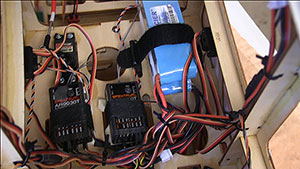 |
| We already had a How-To story in progress on setting up a dual receiver system and the new Valiant seemed like a great platform for that installation. Click image to enlarge |
The much lower current demands of the HiTec HS-5565MH servos driving decidedly non-3D-sized control surfaces made my normal dual 5000mAh, 7.4V LiPo’s’ overkill of the first order. I was routinely going home from a full days flying with 85% (and more) of battery capacity remaining. Going to receiver packs in the 2300mAh range will leave a few more ounces on the bench.
Though I love the look of the Hangar 9 Valiant on the big DuBro balloon tires they weigh a ton. Actually, 1998lbs under a ton but still much heavier than the tires/wheels that came with my Top Flite P51. The DuBro 6” balloon tires weigh 11.4oz each or 22.8oz for the pair. The foam tires from the P51 kit weigh just 2.6oz each or 5.2oz together. That’s going from 1lb 6.8oz for the balloon tires to 5.8oz for the pair of foam tires. A total wheel weight savings of 1lb 1oz is significant even in a giant scale plane.
I am still skeptical that the foam tires can withstand my touch and go addiction even though they are designed for a plane of very similar weight. Until the foam tires prove to be capable the DuBro 6” balloon tires will be in the trailer just in case.
I had hoped to find carbon fiber main gear that would fit the Hangar 9 Valiant but no joy on that count. I considered having the carbon fiber gear made up but it turns out the people making them are really proud of them and charge accordingly. The first Hangar 9 Valiant flew just fine with the included aluminum gear so Hangar 9 Valiant #2 will be just fine with the other weight reductions I have been able to make.
Altogether I was able to shave roughly 1.875lbs off the new Hangar 9 Valiant. Considering the surprisingly nimble handling the first one had, I am looking forward to the new Hangar 9 Valiant being even more fun for me to fly and even more impressive for first time viewers of its capabilities.
Breathing LiFe into the new Hangar 9 Valiant
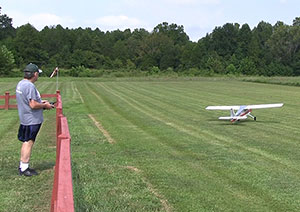 |
| From the maiden flight on, the new Valiant flew great. I don't think this plane knows how to fly badly! Click image to enlarge |
Over the years I have received a reasonably consistent flow of email regarding my use of LiPo receiver/servo batteries. I understand people being hesitant to put LiPo batteries in an airplane but I think that I do it safely by using good quality batteries, a good charger and always low charge rates. However, I think there is merit in the LiFe batteries so I am going to use them in the new Hangar 9 Valiant.
The new Hangar 9 Valiant sports a pair of 2100mAh, 6.6V LiFe packs from Glacier. The 7.4V, 5000mAh LiPo packs I normally used weigh in at 7.1 oz each or 14.2oz actual flying weight for the pair. The pair of Glacier 6.6V, 2100mAh LiFe packs weigh 4.24oz each or 8.48oz flying weight for the pair. That comes out to a total weight reduction of 5.72oz which on its own isn’t a big deal but will contribute to the overall weight reduction.
Robart Hinges
Most of the Hangar 9 Valiant hinging is done with large CA hinges and they had performed perfectly in my first Hangar 9 Valiant. The flaps use good-sized pin hinges to accommodate the knee-like movement they need. As on my first Hangar 9 Valiant I will be using Robart pin hinges in their place. The hinges supplied by Hangar 9 look fine. This is where my old-school is hanging out and I use Robarts because I always have and never had an issue with them. In this case I used the Robart Super Hinge Points, Robart #310.
Also, though I have had it suggested by FlyingRC.net viewers I did not install the Robart pin hinges with medium CA adhesive. I know some people do and get away with it. I tend to fly a plane like this a lot and use the hinges pretty much every minute of those flights so I will continue to use 30-minute epoxy and dare the hinges to pull free. Besides, I try to do hinging on days when there is a NCIS marathon on TV so I can watch that while the epoxy sets up. Perhaps another iteration of my old-school persona.
At the Field
I admit that I was a little concerned with taking my new Hangar 9 Valiant up for the first time using the dual receiver system. I knew this is a solid approach to receiver redundancy but I had some “first time” jitters. Those went away shortly after the Hangar 9 Valiant broke free of the ground and the familiar thrill of flying this plane came back to me.
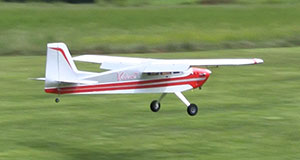 |
| The flaps on the Valiant are fully functional and give this plane an extra dimension that is lots of fun to explore. Click image to enlarge |
The Hangar 9 Valiant needed a few clicks of down elevator and about the same number of right clicks to the ailerons. During the first flight, I also dialed in a little up elevator in the Normal flight mode and some down elevator in the landing mode. After flying the first Hangar 9 Valiant I learned that having the two flight modes helped give me a solid feel during wide open throttle and at idle like during landing approaches. I like to be holding just a little up elevator during landing as that just feels better to me. The Hangar 9 Valiant such a wide, stable flight envelope that I can play with subtle trim changes without feeling like the plane is at risk.
Changes like this are best done with some altitude until you know how the plane responds. With those minor trim changes the new Hangar 9 Valiant started feeling much like its predecessor. It wasn’t long before I was going to full-flaps and doing touch and goes.
The new Hangar 9 Valiant was handling well but seemed a little “jittery” during the first flight, nothing bad just different than the original. After landing, I went into the transmitter to see what dual rates and expo’s I had programmed in and found the problem. I had forgotten to do that programming so was flying the Hangar 9 Valiant at maximum deflection with no dual rates or expo at all. Despite this forgotten programming the Hangar 9 Valiant was flying nicely and was totally controllable, just a little more aggressive in its response to stick inputs than I recalled on the first Hangar 9 Valiant. That is testament to the superior handling of this airframe. It is hard to mess it up!
DLE40 Twin
Now in its fourth airframe, the DLE40 Twin was once again running great. I didn’t have to change the mixture screws at all and only minor tweaks to the throttle linkage was needed. As when in the previous Hangar 9 Valiant, the DLE40 Twin had very good throttle response and literally “sipped” fuel. The new 16oz tank was giving me 8-minute flights with well over half a tank of fuel left. I will start bumping up the flight time until the normal excess fuel reaches ¼-tank or so.
It’s hard to imagine the actual number of hours on the DLE40 Twin but I know it is a lot. All the planes it has been in were flown heavily. The Pilot Yak and the AeroWorks 35cc Freestyle Extra 260 were literally flown hard until the airframe began weakening under the onslaught of high-speed “maneuvers” and literally thousands of touch and goes. I rebuilt the carb once long ago but to this day, get fuel to the carb and it starts and runs easily. Great motor!
Hangar 9 Quarter Scale Float Kit
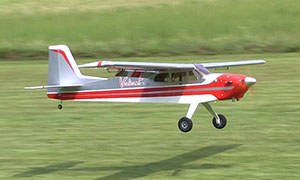 |
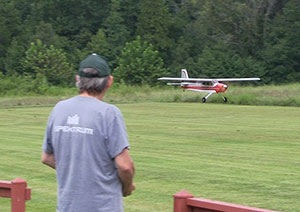 |
| Despite its size, the Valiant is capable of remarkably slow flight (left) with the flaps fully deployed. I am addicted to doing touch-and-goes (right) with the Valiant in large part because it is so much fun to fly low and slow or faster and way more aerobatic than expected from this large of a plane. Click images to enlarge |
|
Part of the new Hangar 9 Valiant project is to get it ready and on floats for the second Float Fly at the Smith Lake Flyers lake. When a friend in Texas offered to supply a new airframe, I jumped at the chance as I badly wanted to return to the Float Fly where the old Hangar 9 Valiant met its end. That was my first float experience and with the help of the super stable Hangar 9 Valiant platform I had a ball, right up until the receiver (also in its third or fourth plane, lots of hours) gave up and began issuing random control commands. The first Hangar 9 Valiant did not survive that incident but everything inside it, except for the receiver lived through the incident and now populates the new Hangar 9 Valiant.
Now with the new Hangar 9 Valiant maidened and all its systems working well I can devote time to getting the floats built (they are going together on the bench in front of me as I write this) and ready for the lake. Flying off water aside, this is just another excuse to spend at a day flying RC with a group of very nice people!
Conclusions
When I lost the first Hangar 9 Valiant I knew that I would have another sometime, somehow. I enjoy tearing holes in the sky with a hot 3D plane as much as anyone but there is something about the Hangar 9 Valiant and its huge flight envelope that makes it hugely enjoyable to fly. It is very responsive to the rudder without the ill-handling consequences shown by many airframes.
Though not a recommended maneuver with the Hangar 9 Valiant, I have snap-rolled it on takeoff, something that shocks spectators. The down side is that I have bent the large aluminum wing tube doing a snap-roll on takeoff at the reduced speed then.
With a little practice, you can do impressive-looking rolling turns or circles with the Hangar 9 Valiant. The roll rate is understandably slow because of the physics barriers of rotating such a huge wing. However, that makes it easier to do rolling circles using the elevator to maintain altitude and turn the Hangar 9 Valiant where you want it.
Video Tour |
The flaps are fully functional and slow the Hangar 9 Valiant to a walk (literally) if there is any headwind on the runway. Add some Crow (See Resources below) to the programming and the Hangar 9 Valiant is capable of even slower flight on approach. With full flaps deployed the Hangar 9 Valiant is almost comfortable flying sideways when you add a bunch of rudder and enough aileron, elevator and throttle to maintain altitude.
I suspect the only RC pilots that don’t like the Hangar 9 Valiant are those who have not flown one. This plane is addictive in the best sense of that word. Along with the huge flight envelope the Hangar 9 Valiant handles flying in wind surprisingly well. Have done my incessant touch and go routine in winds between 10 and 20mph with little trouble other than the Hangar 9 Valiant wanting to keep flying. As the wind kicks up you may have to add a few clicks of down elevator to help fly the Hangar 9 Valiant back down to the ground.
If you are looking for a fun, giant scale plane that uses an economically-priced engine you need to check out the Hangar 9 Valiant. Hangar 9 has been in the RC airframe business for a long time so it is no surprise that the Hangar 9 Valiant flies so well. Also, the number of smaller Valiant versions coming to the market is testament to the built-in superior handling.
Resources
Setting Up Crow in the Spektrum
E-flite Valiant 1.3m Park Flyer BNF Basic Review
Have a comment on this Review? –Email Me!
All Flyingrc.net written, photographic and drawn materials are property of and copyright by Tom Hintz and Flyingrc.net 2013-2020 Materials cannot be used in any way without the prior written permission of the owner.
Privacy Statement


